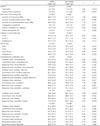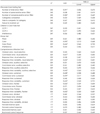Abstract
Objectives
Methods
Results
Figures and Tables
Table 2

* : Numbers may not add up to the same total because of missing values, † : Test was not applied when it is not appropriate to age, ‡ : Difference between the two groups was significant when corrected for multiple comparisons. ADHD : Attention-deficit/hyperactivity disorder, CAT : Comprehensive Attention Test, CCTT : Children's Color Trails Test, SNAP : Swanson, Nolan and Pelham-IV, WCST : Wisconsin Card Sorting test
Table 3

* : Numbers may not add up to the same total because of missing values or because test was not applied when it is not appropriate to age, † : Statistically significant discrimination ability of ADHD (AUC>0.5). 95% CI : 95% confidence interval, ADHD : Attention-deficit/hyperactivity disorder, AUC : Area under the curve, CAT : Comprehensive Attention Test, CCTT : Children's Color Trails Test, ROC : Receiver operating characteristic, WCST : Wisconsin Card Sorting test
Table 4

* : p<0.05, ** : p<0.01, *** : p<0.001 when corrected for multiple comparison. CAT : Comprehensive Attention Tests, CCTT : Children's Color Trails Test, CCTT1 : CCTT1 time score, CCTT2 : CCTT2 time score, CCTT3 : CCTT interference score, SNAP1 : SNAP, Swanson, Nolan and Pelham-IV inattention score, SNAP2 : SNAP, Swanson, Nolan and Pelham-IV hyperactivity-impulsivity score, Stoop1 : Stroop Test Word score, Stoop2 : Stroop Test Color score, Stoop3 : Stroop Test Color-Word score, Stoop4 : Stroop Test Interference score, WCST : Wisconsin Card Sorting Test, WCST1 : Number of total errors (% ile); WCST2, Number of perseverative errors (% ile); WCST3, Number of nonperseverative errors (% ile); WCST4 : Categories completed, WCST5 : Trials to complete 1st category, WCST6 : Failure to maintain set
Table 5

* : p<0.05 when corrected for multiple comparison. CAT : Comprehensive Attention Tests, CCTT : Children's Color Trails Test, CCTT1 : CCTT1 time score, CCTT2 : CCTT2 time score, CCTT3 : CCTT interference score, SNAP1 : SNAP, Swanson, Nolan and Pelham-IV inattention score, SNAP2 : SNAP, Swanson, Nolan and Pelham-IV hyperactivity-impulsivity score, Stoop1 : Stroop Test Word score, Stoop2 : Stroop Test Color score, Stoop3 : Stroop Test Color-Word score, Stoop4 : Stroop Test Interference score, WCST : Wisconsin Card Sorting Test, WCST1 : Number of total errors (% ile), WCST2 : Number of perseverative errors (% ile), WCST3 : Number of nonperseverative errors (% ile), WCST4 : Categories completed, WCST5 : Trials to complete 1st category, WCST6 : Failure to maintain set




 PDF
PDF ePub
ePub Citation
Citation Print
Print



 XML Download
XML Download